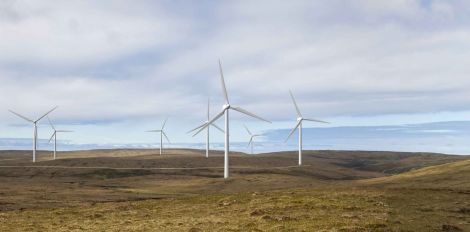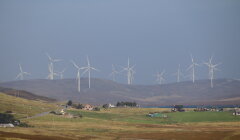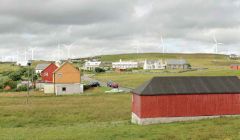Energy / Campaigner says Yell wind farm approval was ‘depressingly familiar’
MONDAY’s announcement that the Energy Isles wind farm in Yell had been given consent by the Scottish Government was “depressingly familiar”.
That is the view of campaigner Frank Hay, who is the chairman of Sustainable Shetland.
In his view the granting of consent was “quite a shameful decision for an area that is relatively unspoilt peatland”.
Developer Statkraft says the 18-turbine wind farm, which would be located west of Cullivoe, could begin construction by 2025 – with the aim of having it operational by early 2027.
The Scottish Government’s decision letter said: “The Scottish ministers acknowledge that the proposed development would result in some impacts, which are considered acceptable in the context of the benefits and positive effects that the proposed development will bring in terms of net economic benefit, contributing to renewable energy and climate change targets.”
Sustainable Shetland was formed in 2008 in response to proposals for Viking Energy, with the group opposing large wind farm developments and favouring “fit for scale” projects instead.
In addition to Energy Isles, consent is in place for Yell’s Beaw Field (17 turbines) and the 12-turbine Mossy Hill near Lerwick. The 103-turbine Viking Energy wind farm is under construction and is expected to feed electricity into the grid by autumn next year.
Chairman Hay claimed it was “clear” that Energy Isles “does not enjoy unanimous support from local residents and the delight of local investors is not shared by all”.
He pointed to initial objections during the planning process from the likes of John Muir Trust, Shetland Amenity Trust, RSPB and Shetland Bird Club, as well as some members of the public.
“Given the large number of issues surrounding this application, a public inquiry would have been justified but, unfortunately, the Scottish Government did not agree,” Hay said.
Become a member of Shetland News
“This project is more to do with money and making the most of financial opportunities rather than any genuine desire to be ‘green’.
“Sadly the local environment and wildlife will be will be the losers if this project finally moves on to the construction phase.”
Hay also suggested that “value for money to consumers is highly doubtful and any contribution to saving the planet negligible”.
Commenting this week, Statkraft’s principal project manager for Energy Isles Rebecca Todd said: “This is one of Statkraft’s most important projects, and will generate a significant amount of renewable electricity, while improving energy security.
“Alongside this, Energy Isles will deliver at least £18.9m through a Community Benefit Fund, for local people.
“This would not have happened without the vision of Shetlanders who started this ambitious scheme back in 2012 and who have supported it all the way through.
“We’d like to thank the people of Shetland and the Energy Isles consortium for their drive and determination to decarbonise the North Isles and the hard work and backing for the project that they have provided.”
Derek Jamieson, from Energy Isles Ltd, also said there was strong support from local folk, including the businesses involved in the consortium which is backing the development.
“We’re very glad that the Scottish Government has recognised how important this project is to sustainability of peerie island communities like ours looking to build towards a greener future,” he added.
Fire safety concern
Meanwhile Lerwick Community Council has formally objected to plans for a battery storage system in the town over continued concerns over fire safety and its proximity to housing.
There is also a confirm about the fumes in the event of a fire.
Zenobe is proposing a system which would allow Shetland to remain powered if there is an outage with the subsea interconnector between the isles and the Scottish mainland, which is under construction.
The batteries would be used when Lerwick Power Station is needing time to move out of standby mode.
An application for the system, which would be based on land opposite the power station, is currently being considered by the Scottish Government’s Energy Consents Unit as its capacity is above 50MW.
Become a member of Shetland News
Shetland News is asking its many readers to consider paying for membership to get additional features and services: -
- Remove non-local ads;
- Bookmark posts to read later;
- Exclusive curated weekly newsletter;
- Hide membership messages;
- Comments open for discussion.
If you appreciate what we do and feel strongly about impartial local journalism, then please become a member of Shetland News by either making a single payment, or setting up a monthly, quarterly or yearly subscription.













































































